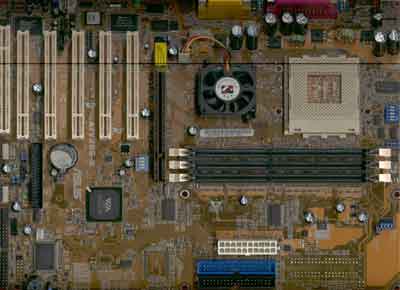VIA KT266A Motherboard Roundup - January 2002
by Mike Andrawes on January 18, 2002 4:48 AM EST- Posted in
- Motherboards
ASUS A7V266-E
|
ASUS A7V266-E |
|
|
CPU
Interface
|
Socket-A
|
|
Chipset
|
VT8366A
North Bridge
VT8233 South Bridge |
|
Form
Factor
|
ATX
|
|
Bus
Speeds
|
100
- 227MHz (in 1MHz increments)
|
|
Core
Voltages Supported
|
1.700
- 1.850V (in 0.025V increments)
|
|
I/O
Voltages Supported
|
Not
Configurable
|
|
DRAM
Voltages Supported
|
2.5 / 2.6 / 2.7 / 2.8 V
|
|
Memory
Slots
|
3
184-pin DDR DIMM Slots
|
|
Expansion
Slots
|
1
AGP Pro Slot
5 PCI Slots 1 ACR Slot |
|
Onboard
RAID
|
Promise
PDC20265
|
|
Onboard
USB 2.0/IEEE-1394
|
N/A
|
|
Onboard
Audio
|
C-Media
CMI 8738
|
Compared to the A7A266-E, the A7V266-E is a much better DDR solution from ASUS. However, it doesn't seem to be as unique when compared to its esteemed competitors in this roundup.
The board offers a very wide range of FSB speed settings, and you can monitor the PCI bus speed you will be running as well. However, just like the A7A266-E, the A7V266-E only provides a 1/4 divider for the PCI bus.
It's been a classic ASUS trait to provide more voltage to the CPU thus improving stability a bit. In our tests we noticed that even at default settings, the CPU was running at almost 1.80V instead of 1.75V, a 2.8% differential. This gap continues when we continued to increase the CPU voltage, which means you are always running a higher voltage than what you expected.
Although it wasn't available on our evaluation sample, the A7V266-E also has an optional RAID controller. ASUS continues to use the Promise PDC20265 controller, which supports ATA100 RAID. The board also features the C-Media CMI8738 PCI 6 channel-LX sound chip. Although the board doesn't overclock as nicely as we expected, it was again very stable during our tests which has become ASUS' trademark.
In short, the A7V266-E is a very solid KT266A solution from ASUS, although it falls behind in terms of board features. ASUS has definitely lost the overclocking game with their KT266A board, but hopefully their next solution will restore some of that competitive spirit to the motherboard titan.











3 Comments
View All Comments
Anonymous User - Monday, September 29, 2003 - link
How do I get my Engine to Memory clock to run synchronous for my Epox 8kha+ boardxrror - Saturday, August 14, 2021 - link
This was such an exciting time in PC hardware. Intel was still trying to cram Rambus down the industry's throat - and obstinately trying to strong arm the mobo makers and force chipset makers to Rambus licensing. We still had VIA, SiS, ULi, and even nVidia in the chipset market, and with AMD's Athlon line still extraordinarily competitive and Intel in full attack they could no longer just consider AMD as a side-show - this was their leverage against Intel and they had to treat Socket A as premium platform.NegativeROG - Wednesday, June 15, 2022 - link
I still have this board. AND, I invested all of a $10,000 inheritance in Rambus RDRAM. I'm smarter now (I hope). But, you are right about exciting times in the PC space. I navigated away from AMD for a bit, but came back, and will stay forever. Team RED!